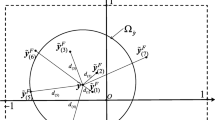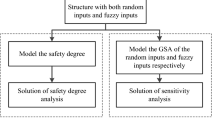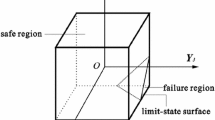Abstract
In the presence of both random and interval hybrid uncertainty (RI-HU), investigating global reliability sensitivity (GRS) can identify the effect of random input on the structural safety globally. To this end, this work establishes the GRS index model and its corresponding efficient solution, and the innovation includes three aspects. Firstly, the GRS of the random input is defined by the average absolute difference between the failure probability upper bound (FP-UB) and the conditional FP-UB on the fixed random input under the RI-HU, and it can reflect the effect of the fixed random input on the structural safety. Secondly, the conditional FP-UB on fixing the random input at the realization is approximated by the conditional FP-UB on fixing the random input in a differential interval. Then the conditional probability theorem can be employed to convert estimating the GRS into the state recognition of the samples, which is the by-product of estimating the FP-UB by the numerical simulation. Finally, by the strategy of surrogating the performance function twice, the meta-importance sampling method is developed to efficiently estimate the GRS in presence of the RI-HU. The rationality of the proposed GRS index model and the efficiency of the developed estimation method are fully verified by the numerical and engineering examples.







Similar content being viewed by others
References
Amouzgar K, Stromberg N (2017) Radial basis functions as surrogate models with a priori bias in comparison with a posteriori bias. Struct Multidiscip Optim 55(4):1453–1469
Au SK (2004) Probabilistic failure analysis by importance sampling Markov chain simulation. J Mech Des 130:303–311
Bourinet JM (2016) Rare-event probability estimation with adaptive support vector regression surrogates. Reliab Eng Syst Saf 150:210–221
Bourinet JM, Deheeger F, Lemaire M (2011) Assessing small failure probability by combined subset simulation and support vector machines. Struct Saf 33(6):343–353
Brevault L, Lacaze S, Balesdent M et al (2016) Reliability analysis in the presence of aleatory and epistemic uncertainties, application to the prediction of a launch vehicle fallout zone. J Mech Des 138:401–411
Cadini F, Gioletta A, Zio E (2014) An improvement of a meta model-based importance sampling algorithm for estimating small failure probabilities. Int Conf Vulnerability Risk Anal Manag, 2104–2114
Cheng K, Lu ZZ (2018) Sparse polynomial chaos expansion based on DMORPH regression. Appl Math Comput 323:17–30
Cui LJ, Lu ZZ, Zhao XP (2010) Moment-independent importance measure of basic random variable and its probability density evolution solution. Sci China Technol Sci 53(4):1138–1145
Du XP (2007) Interval reliability analysis. Proceedings of ASME 2007 International Design Reliability Handbook. Computer and Information in Engineering Conference, Las Vergas
Du XP (2008) Unified uncertainty analysis by the first order reliability method. AMSE J Mech Design 130(9):1404–1404
Dubourg V, Sudret B, Deheeger F (2013) Metamodel-based importance sampling for structural reliability analysis. Probabilistic Eng Mech 33:47–57
Echard B, Gayton N, Lemaire M (2011) AK-MCS: an active learning reliability method combining Kriging and Monte Carlo simulation. Struct Saf 33(2):145–154
Fauriat W, Gayton N (2014) AK-SYS: an adaptation of the AK-MCS method for system reliability. Reliab Eng Syst Saf 123:137–144
Feng KX, Lu ZZ, Yun WY et al (2019a) An innovative estimation of failure probability function based on conditional probability of parameter interval and augmented failure probability. Mech Syst Signal Process 123:606–625
Feng KX, Lu ZZ, Yun WY (2019b) Aircraft icing severity analysis with hybrid parameters under considering epistemic uncertainty. AIAA J 57(4):1514–1522
Guo J, Du XP (2009) Reliability sensitivity analysis with random and interval variables. Int J Numer Methods Eng 78:1585–1617
Han X, Jiang C, Liu LX et al (2014) Response-surface-based structural reliability analysis with random and interval mixed uncertainties. Sci China Technol Sci 57(7):1322–1334
Hu Z, Mahadevan S (2016) A single-loop kriging surrogate modeling for time-dependent reliability analysis. J Mech Des 138(6):1406–1416
Hurtado JE, Alvarez DA (2014) An efficient method for the estimation of structural reliability intervals with random sets, dependence modeling and uncertain inputs. Comput Struct 142:54–63
Hurtado JE, Alvarez DA, Paredes JA (2017) Interval reliability analysis under the specification of statistical information on the input variables. Struct Saf 65:35–48
Jiang C, Lu GY, Han X et al (2012) A new reliability analysis method for uncertain structures with random and interval variables. Int J Mech Mater Design 8:169–182
Li LY, Lu ZZ, Feng J et al (2012) Moment-independent importance measure of basic variable and its state dependent parameter solution. Struct Saf 38:40–47
Ling CY, Lu ZZ (2019) A novel extended crossing rate method for time-dependent hybrid reliability analysis under random and interval inputs. Eng Optim 52:1720–1742. https://doi.org/10.1080/0305215X DOS: 2019, 1677633
Liu JS (2001) Monte Carlo strategies in scientific computing. Springer, New York
Lu H, Shangguan WB, Yu DJ (2018) A new hybrid uncertainty analysis method and its application to squeal analysis with random and interval variables. Probabilistic Eng Mech 51:1–10
Meng Z, Keshtegar B (2019) Adaptive conjugate single-loop method for efficient reliability-based design and topology optimization. Comput Methods Appl Mech Eng 344:95–119
Meng Z, Hui ZZ, Li G, Zhang DQ (2020a) An active weight learning method for efficient reliability assessment with small failure probability. Struct Multidiscip Optim 61:1157–1170
Meng Z, Hui ZZ, Zhou HL (2020b) A novel experimental data-driven exponential convex model for reliability assessment with uncertain-but-bounded parameters. Appl Math Model 77:773–787
Wang ZQ, Wang PF (2015) A double-loop adaptive sampling approach for sensitivity-free dynamic reliability analysis. Reliab Eng Syst Saf 142:346–335
Wang WX, Gao HS, Zhou CC et al (2018a) Reliability analysis of motion mechanism under three types of hybrid uncertainties. Mech Mach Theory 121:769–784
Wang YP, Xiao SN, Lu ZZ (2018b) A new efficient simulation method based on Bayes’ theorem and importance sampling Markov chain simulation to estimate the failure-probability-based global sensitivity measure. Aerosp Sci Technol 79:364–372
Wang YP, Xiao SN, Lu ZZ (2018c) An efficient global reliability sensitivity analysis algorithm based on classification of model output and subset simulation. Struct Saf 74:49–57
Xiao SN, Lu ZZ (2017) Structural reliability sensitivity analysis based on classification of model output. Aerosp Sci Technol 71:52–61
Xiao NC, Huang HZ, Wang ZL et al (2012) Unified uncertainty analysis by the mean value first order saddle point approximation. Struct Multidiscip Optim 46:803–812
Yang XF, Liu YS, Gao Y et al (2015) An active learning Kriging model for hybrid reliability analysis with both random and interval variables. Struct Multidiscip Optim 51:1003–1016
Yun WY, Lu ZZ, Jiang X (2018) An efficient global reliability sensitivity analysis algorithm based on classification of model output and subset simulation. Struct Saf 74:49–57
Yun WY, Lu ZZ, Jiang X (2019) An efficient method for moment-independent global sensitivity analysis by dimensional reduction technique and principle of maximum entropy. Reliab Eng Syst Saf 187:174–182
Yun WY, Lu ZZ, Feng KX et al (2020) Two efficient AK-based global reliability sensitivity methods by elaborative combination of Bayes’ theorem and the law of total expectation in the successive intervals without overlapping. IEEE Trans Reliab 69(1):260–276 6
Zhang JH, Xiao M, Gao L et al (2018) A novel projection outline based active learning method and its combination with Kriging metamodel for hybrid reliability analysis with random and interval variables. Comput Methods Appl Mech Eng 341:32–52
Funding
This work was supported by the National Natural Science Foundation of China (Grant no. NSFC 52075442 and NSFC 12002237) and National Science and Technology Major Project (Grant no. 2017-IV-0009-0046).
Author information
Authors and Affiliations
Corresponding author
Ethics declarations
Conflict of interest
The authors declare that they have no conflict of interest.
Consent for publication
We would like to declare that the work described was original research that has not been published previously, and not under consideration for publication elsewhere, in whole or in part.
Replication of results
The MATLAB codes used to generate results are available in the supplementary material.
Additional information
Responsible editor: Christian Gogu
Publisher's note
Springer Nature remains neutral with regard to jurisdictional claims in published maps and institutional affiliations.
Supplementary information
ESM 1
(rar 7.57 kb)
Appendix
Appendix
1.1 SL-AK-MCS for GRS in presence of RI-HU
The basic idea of SL-AK-MCS is to build a single Kriging model to surrogate performance function with random and interval inputs directly. The strategy of constructing Kriging model to surrogate performance function in presence of RI-HU in SL-AK-MCS method is similar with the strategy of constructing \( {g}_{K_2}\left(\boldsymbol{x},\boldsymbol{y}\right) \) listed in Subsection 3.2.2 of this work. The main implementation procedures of SL-AK-MCS for GRS in presence of RI-HU are summarized briefly as follows:
-
(1)
Construct the initial Kriging model gK(x, y).
Generate Nx ‐ size sample pool \( {S}_x=\left\{{x}_1,{x}_2,\dots, {x}_{N_x}\right\} \) according to the joint PDF fX(x) of the random inputs and Ny ‐ size sample pool \( {S}_y=\left\{{y}_1,{y}_2,\dots, {y}_{N_y}\right\} \) of interval variables according to y ∈ [yL, yU]. Randomly select N1 training samples from Sx and Sy to constitute initial training samples \( \left({\boldsymbol{x}}_k^T,{\boldsymbol{y}}_k^T\right)\left(k=1,2,\dots {N}_1\right) \); then compute the corresponding performance functions, and construct the initial training set \( T=\left\{\Big(\left({x}_k^T,{y}_k^T\right),g\Big({x}_k^T,{y}_k^T\left)\right),k=1,2,\dots {N}_1\right\} \).
-
(2)
Select new training samples according to the criterions listed in Subsection 3.2.2 (2).
-
(3)
Judge the convergence of gK(x, y) according to the criterions listed in Subsection 3.2.2 (3). When gK(x, y) is convergent, turn to Step (4). Otherwise, turn to Step (2), and select new training samples to refine T to update gK(x, y).
-
(4)
Estimate the FP-UB \( {P}_f^U \) and obtain failure samples.
Predict the failure domain indicator function value \( {\hat{I}}_{F_{\mathrm{min}}}\left({\boldsymbol{x}}_i\right) \) by (A1) at sample points xi(i = 1, 2, …, Nx) in the sample pool Sx by the convergent gK(x, y):
Then the failure samples can be obtained, and the estimate \( {\hat{P}}_f^U \) of \( {P}_f^U \) can be estimated as follows:
-
(5)
Estimate GRS in presence of RI-HU according to (18) using strategies revealed in Subsection 3.2.3.
1.2 DL-AK-MCS for GRS in presence of RI-HU
The DL-AK-MCS strategy builds two nested Kriging models to estimate the \( {P}_f^U \) in the presence of RI-HU. In the inner loop, the Kriging model gK(x∗, y) surrogating the relation of performance function with respect to the interval inputs on the random input vector fixed at x∗ is built, which is responsible for searching the minimum of performance function at the fixed random input x∗. In the outer loop, the Kriging model GeK(x) for the minimum surface Ge(x) = min {g(x, y), y ∈ [yL, yU]} should be built, which is a model respect to the random input vector and is used for reliability analysis. After the outer Kriging model is convergent, the FP-UB and failure samples can be obtained, and (18) can be used to estimate the GRS in presence of RI-HU. The main implementation procedures of DL-AK-MCS for GRS in presence of RI-HU are summarized as follows:
-
(1)
Generate Nx ‐ size sample pool \( {S}_x=\left\{{x}_1,{x}_2,\dots, {x}_{N_x}\right\} \) according to the joint PDF fX(x) of the random inputs. Randomly select \( {N}_1^x \) random samples \( {\boldsymbol{x}}_k^T\left(k=1,2,\dots {N}_1^x\right) \) from Sx as the initial training samples for the outer loop Kriging model.
-
(2)
Construct the inner loop Kriging model gK(x∗, y) at the fixed random input x∗.
-
1)
Generate sample pool \( {S}_y=\left\{{y}_1,{y}_2,\dots, {y}_{N_y}\right\} \) of interval variables according to y ∈ [yL, yU]. Select \( {N}_1^y \) samples \( {\boldsymbol{y}}_k^T\left(k=1,2,\dots {N}_1^y\right) \) from Sy. Compute the actual performance function values \( g\left({x}^{\ast },{y}_k^T\right)\left(k=1,\dots, {N}_1^y\right) \), and construct training set \( {T}^y=\left\{\Big({y}_k^T,g\left({x}^{\ast },{y}_k^T\right)\Big),\Big(k=1,\dots, {N}_1^y\Big)\right\} \).
-
2)
Build the inner loop Kriging model gK(x∗, y) using training set Ty.
-
3)
Estimate the expected maximum improvement E(I(y)) by (A3) for samples in Sy:
where \( {g}_K^{\mathrm{min}}\left({x}^{\ast}\right)=\underset{y\in \left[{y}^L,{y}^U\right]}{\min }{g}_K\left({x}^{\ast },y\right) \). The expected maximum improvement E(I(y)) is an extension of the one in Ref. (Wang and Wang 2015).
-
4)
If \( \underset{y\in {S}_y}{\max }E\left(I(y)\right)\ge {C}_B \) (CB is the stopping condition corresponding to E(I(y)), which has been provided in Ref. (Wang and Wang 2015)), select the new training sample by \( {y}^u=\arg \underset{y\in {S}_y}{\max }E\left(I(y)\right) \). Let \( {T}^y=\left\{{T}^y\cup \Big({y}^u,g\left({x}^{\ast },{y}^u\right)\Big),\Big(k=1,\dots, {N}_1^y\Big)\right\} \), and return to Step (2). Otherwise, terminate updating the inner loop Kriging model, and go to Step (4).
-
(4)
Obtain \( {G}_e\left({x}_k^T\right)=\underset{y\in \left[{y}^L,{y}^U\right]}{\min }{g}_K\left({x}_k^T,y\right)\left(k=1,2,\dots, {N}_1^x\right) \) using the inner loop Kriging model gK(x∗, y) obtained in Step (3). Let \( {T}^x=\left\{\Big({x}_k^T,{G}_e\left({x}_k^T\right)\Big),\Big(k=1,\dots, {N}_1^x\Big)\right\} \).
-
(5)
Construct the outer loop Kriging model GeK(x) by Tx.
-
(6)
Judge the convergence of GeK(x)according to the criterions listed in Subsection 3.2.2 (3).
When the convergence criterion is satisfied, terminate the outer loop iteration and obtain the convergent GeK(x); then go to Step (7). Otherwise, find the new training sample by \( {x}^u=\arg \underset{x\in {S}_x}{\max }{C}_A(x) \), where CA(x) is a learning function for the selection of samples proposed in Ref. (Wang and Wang 2015). Compute \( {G}_e\left({x}^u\right)=\underset{y\in \left[{y}^L,{y}^U\right]}{\min }{g}_K\left({x}^u,y\right) \) by the inner loop Kriging model gK(x∗, y) obtained in Step (3). Let \( {T}^x=\left\{{T}^x\cup \Big({x}^u,{G}_e\left({x}^u\right)\Big),\Big(k=1,\dots, {N}_1^x\Big)\right\} \), and go to Step (5).
-
(7)
Estimate \( {P}_f^U \) using (A4) and obtained failure samples:
where IF(GeK(xi)) is the indicator function of failure domain F = {x : GeK(x) ≤ 0}. If GeK(x) ≤ 0, IF(⋅) = 1. If GeK(x) > 0, IF(⋅) = 0..
Rights and permissions
About this article
Cite this article
Zhou, S., Lu, Z., Ling, C. et al. Global reliability sensitivity analysis index and its efficient numerical simulation solution in presence of both random and interval hybrid uncertainty. Struct Multidisc Optim 63, 551–573 (2021). https://doi.org/10.1007/s00158-020-02807-w
Received:
Revised:
Accepted:
Published:
Issue Date:
DOI: https://doi.org/10.1007/s00158-020-02807-w




